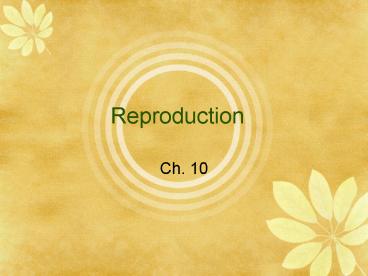Reproduction - PowerPoint PPT Presentation
1 / 25
Title: Reproduction
1
Reproduction
- Ch. 10
2
Asexual Reproduction
- One parent
- One nucleus
- Offspring are identical to parent and each other.
3
Binary Fission
- Prokaryotic cells
- One cell splits into two cells
- Ex. bacteria
4
(No Transcript)
5
Budding
- New individual starts as an outgowth on the
parent and separates - Ex. Hydra and potato eyes
6
(No Transcript)
7
Cloning
- Involves the transfer of a body cell nucleus into
an ovum - Ex. Dolly the sheep
8
(No Transcript)
9
Fragmentation
- A piece of the parent breaks off and grows into a
new organism. - Ex. Sea star
10
Mitosis
- Eukaryotic cells
- Nucleus divides into two then one cell divides
into two. - Ex. Ameba and skin cells
11
(No Transcript)
12
Sporulation
- Process that produces spores (asexual)
- Spores are cells that grow into a new organism
- Ex. Mushrooms
13
(No Transcript)
14
Vegetative Reproduction
- Involves part of an organism that is not usually
used for reproduction. - Ex. Plant cutting uses a stem or leaf to grow a
new plant
15
(No Transcript)
16
Sexual Reproduction
- Two parents
- Two gametes
- Two nuclei join into one nucleus
- Offspring are NOT identical to either parent or
to each other.
17
Gametes
- Reproductive cells
- Eukarytoes
- Produced by a process called meiosis
- Contain only half the genetic information needed
by an organism
18
Fertilization
- Joining (fusion) of 2 gametes
19
Gestation
- Internal incubation period for embryos
- Ex. human pregnancy lasts 9 months
20
Meiosis
- Type of cell division
- Produces gametes
21
Ova (aka egg)
- Female gamete
- Larger than sperm
- Contains structures and nutrients needed in early
development
22
Sperm
- Male gamete
- Moves with a flagellum
- Contains many mitochondria and enzymes
23
Zygote
- Single cell
- Results from the joining of the egg nucleus and
sperm nucleus.
24
Embryo
- Forms as soon as the zygote divides into two
cells. - Stage of development that lasts until 8 weeks in
humans
25
Fetus
- Developing human from three months to birth































